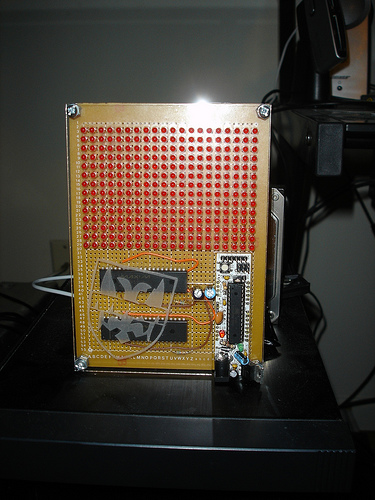LED Array Card
Appearance
LED Array Card
[edit | edit source]Description
[edit | edit source]This was a project I did for my brother's wedding. I wanted to give him something cool instead of a cheesy card you'd buy at a hood arse walgreens or some garbage. So this is an LED array card. Pretty cheap in terms of parts chosen... but downright pretty results. Enjoy!
Hardware
[edit | edit source]* LED array consists of 280 red 3mm LEDs bought at MPJA.com 500 for 5 bucks effectively. * MCU is a Boarduino. Arduino compatibly available from adafruit for 15 bucks roughly. * The board is a ratshack throughhole board. Probably a couple bucks. * Various Caps and Resistors... cost negligible. * Array Controllers are 2 MAX6952 LED array controller PDIP chips ( Samples ) * Faceplate is laser cut 1/16 acrylic clear.
Source Code
[edit | edit source]// Max 6952 Example Code For Arduino
// Tested on Boarduino
// Matt Joyce @ NYC Resistor
#define DATAOUT 11//MOSI
#define DATAIN 12//MISO - not used, but part of builtin SPI
#define SPICLOCK 13//sck
#define SLAVESELECT 10//ss
char spi_transfer(volatile char data)
{
SPDR = data;
// Start the transmission
while (!(SPSR & (1<<SPIF))) // Wait the end of the transmission
{
};
return SPDR; // return the received byte
}
void setup()
{
byte i;
byte clr;
pinMode(DATAOUT, OUTPUT);
pinMode(DATAIN, INPUT);
pinMode(SPICLOCK,OUTPUT);
pinMode(SLAVESELECT,OUTPUT);
digitalWrite(SLAVESELECT,HIGH); //disable device
// SPCR = 01010000
//interrupt disabled,spi enabled,msb 1st,master,clk low when idle,
//sample on leading edge of clk,system clock/4 (fastest)
SPCR = 0b01010010;
clr=SPDR;
delay(32);
// Configure Register
write_led_twice(0x04,0x01);
// Intensity Pane 1 and Pane 2
write_led_twice(0x01,0xFF);
write_led_twice(0x02,0xFF);
// Scan Limit
write_led_twice(0x03,0x01);
}
byte write_led(int address, int value)
{
digitalWrite(SLAVESELECT,LOW);
//2 byte opcode
spi_transfer(address);
spi_transfer(value);
delay(36);
digitalWrite(SLAVESELECT,HIGH); //release chip, signal end transfer
}
// Write n times for n chips daisy chained.
byte write_led_twice(int address, int value)
{
digitalWrite(SLAVESELECT,LOW);
//2 byte opcode
spi_transfer(address);
spi_transfer(value);
spi_transfer(address);
spi_transfer(value);
delay(36);
digitalWrite(SLAVESELECT,HIGH); //release chip, signal end transfer
}
void loop()
{
// Testing ROM Character Set
write_led_twice(0x20,0x5e);
write_led_twice(0x21,0x5e);
write_led_twice(0x22,0x5e);
write_led_twice(0x23,0x5e);
delay(4000);
// Testing Programmable RAM Space
write_led_twice(0x05,0x80);
write_led_twice(0x05,0x42);
write_led_twice(0x05,0x61);
write_led_twice(0x05,0x51);
write_led_twice(0x05,0x49);
write_led_twice(0x05,0x46);
write_led_twice(0x20,0x80);
write_led_twice(0x21,0x80);
write_led_twice(0x22,0x80);
write_led_twice(0x23,0x80);
delay(4000);
// Gred Test Register Call
write_led_twice(0x07,0x01);
delay(1000);
// Turn off Test Register
write_led_twice(0x07,0x00);
}
References
[edit | edit source]* http://www.thingiverse.com/thing:45 * http://blip.tv/file/1504611 * http://datasheets.maxim-ic.com/en/ds/MAX6952.pdf * http://www.arduino.cc/
Creator
[edit | edit source]Matt Joyce Thanks to all of NYC resistor for support.
